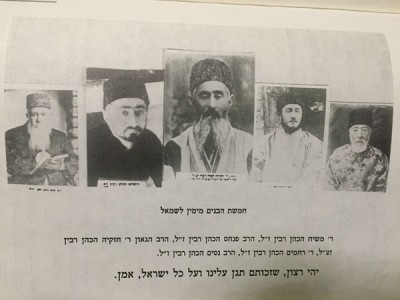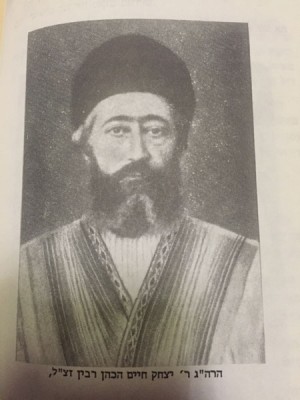


The Gemarah learns from the pasuk “Lo Yamushu Mipikha Umipi Zarakha Umipi Zera Zarakha Meata Vead Olam” that if three generations of Torah can successfully persevere, it will remain in the family (Avloti). Being around many communities, it is clearly evident that this is so: Solovaichik by the Ashkinazim, Halberstam by the Chasidim, Harari Raful by the Syrians, Toledano by the Moroccans, and Baal Hanes by the Persians. The prestigious “Rabin” dynasty amongst the Bukharian community is probably the most famous example by us. Most of this family that exemplifies Chachmat Hatorah lives in Eretz Yisrael, with the exception of our Rav Chagai Niazov (great-grandson of Rav Chizkiyahu Rabin).
Rav Yitschak Chaim Hakohen Rabin
Rav Yitschak Chaim Hakohen Rabin was born in Bukhara in the year 1828. His father was the renowned Rav Pinchas Hagadol. Rav Chaim became Rav in 1868 following the death of his father. He married the granddaughter of Rav Yosef Mamon. Rav Chaim led the community in the footsteps of his father for 38 years. Rav Chaim hosted Baron Binyamin Rothschild in 1889 for five days. (The Baron also spent five days in the house of the philanthropist R’ Ahron Pinchasov “Mulla Niaz.” Rav Chaim gave to Chacham Adler from London archaic manuscripts and old Sifrai Torah from hundreds of years ago. Chacham Adler had it placed in a museum in London. In essence, Rav Chaim is the one who is responsible for producing many famous Bukharian Rabanim who learned Rabanut by him and went on to become Rabanim. These students went abroad to Samarkand, Tashkent, Kakand, and even Yerushalayim. Being that many people were going to Eretz Yisrael at the time, he made aliyah in 1892 along with his son, Mulla Kohen.
At the time that Rav Chaim left Bukhara, the yeshiva system was probably the best it’d been in centuries. Almost every boy five and up was in cheder (yeshiva). It was considered normal for every Bar Mitzvah boy to be fluent in Tinach and well learned in Mishnayot. We can now understand the testimony of all of our grandparents, “Too Ale Ne Medoni Bawvome Kee Boo” (You don’t know who my grandfather was).
Upon Rav Chaim’s arrival, he was accepted with open arms by the Rabanim of Yerushalayim, Chevron, Tiveria, and Tzifat. The community crowned the family with the name Rabin, which means “The Rav of the City” in Russian. His children were Rav Pinchas (Mulaw Kohen) HY”D, Harav Chizkiyahu Rabin, Rav from “1896-1920,” Rav Mashiach Rabin, Rav Rachamim Rabin HY”D, and Rav Nissim Rabin (from Hulon).
The day that Rav Yitzchak Chaim was niftar, the Amir of Bukhara declared a day of commemoration for goyim and Jews alike in recognition of all that he has done for Bukhara. Rav Chaim was nifter on the 3rd of Sivan in the year 1896.
Rav Chizkiyahu Rabin
Rav Chizkiyahu Rabin, born in 1872 was the son and successor of Rav Yitschak Chaim Rabin. Rav Chizkiyahu was an unusual talmid chacham in our community. While the fame of most chachamim in Sefardi countries stayed within the confines of the country, few were globally famous (amongst the Rabanim)–in most cases, due to (halacha) sefarim that were put out. Rav Chizkiyahu began his career at the tender age of 24, upon the death of his father. He lead the community for 24 years until the communists took over and the Amir fled from Bukhara. Rav Chizkiyahu was most famously known for being amongst the Gedolai Torah in the subject of gittin (divorces). Geonim across the world, like the Sidai Chemed, sought his psak (ruling). Very often, no one would want to marry a divorced woman unless her get was obtained through Rav Chizkiyahu. The laws of gittin are very intricate and most Rabbanim do not get involved. Rav Chizkiyahu was the Av Beit Din of Bukhara and the most supreme Halachic authority of his days. In the year 1911, he visited Eretz Yisrael for the first time and was greeted with an entourage of Rabanim. From that day on, any chacham that came to Bukhara resided in his house. When the Bolsheviks took power of Bukhara they oppressed Rav Chizkiyahu immensely and had him imprisoned numerous times. By the skin of his teeth, he fled Bukhara, going first through Afghanistan then Iran (Moshad and Teheran), and finally to Yerushalayimin the year 1935. His wisdom was immediately recognized and he was requested to serve on the “Sefaradi Beit Din” together with geonim like Rav Chizkiyahu Shabtai. Rav Rabin is quoted in Sefer Olat Ish by Rav Elyasheer and in the renowned Sidai Chemed by Rav Chizkiyahu Rabin. Rav Chizkiyahu Hakohen Rabin was niftar on the 9th of Tevet in the year 1945, and was buried on Har Hazaitim.
Mulaw Kohen
Rav Pinchas Hakohen Rabin was born in 1868 to Rav Yitschak Chaim Rabin. He was named after his grandfather, Rav Pinchas Hagadol. Rav Pinchas married Sarah Chacham, the daughter of the illustrious Rav Shimon Chacham. Mulaw Kohen, as he was commonly called, was instrumental in stopping many evil decrees on the Bukharian community and was unanimously appointed as the nasi (president of the community) in the year 1913. He used his power of influence in collaboration with his immense Torah knowledge to benefit the community. When the “Khadi”(ruler) of Shakhrisabz wanted to eliminate the right for Jews to slaughter animals, Mulaw Kohen immediately put a stop to it with the consent of the Emir. He succeeded to convince the jailhouses to let all Jews go home for the Jewish holidays. There used to be a law in Bukhara that no Jew was permitted to leave the city while riding on a horse. When Mulaw Kohen was once told to get off by the border police, he refused. The word quickly reached the palace, and the Emir responded, “Leave Mulaw Kohen alone.” In the year 1921, the Bolsheviks had overthrown the Romanov Empire in Russia, along with the Amir in Bukhara. In effect, that caused Rav Pinchas to run for his life. Rav Pinchas was caught and officially put to death. In reality, Rav Pinchas was alive and fled from amongst the carcasses. He ran to a town called Karshi and hid there for about a week.
His brother, R’ Rachamim, courageously tended to his physical needs and ailments. While attempting to escape through Afghanistan, Rav Pinchas Kohen Rabin succumbed to his ailments and was niftar on the 6th day of Tishrai 1921. R’ Rachamim carried his body back to Bukhara for burial on the first day of Succot. When the authorities found out that R’ Rachamim Rabin assisted his brother, they prosecuted him for harboring a fugitive and had R’ Rachamim Hakohen Rabin killed. May their deaths be avenged.
Rav Pinchas was survived by his son (from a second wife), Harav Hagaon Benzion Rabin, Rav in Tel Aviv during the 1960s, father of the current Dayan Rav Pinchas Rabin, shlita.
Yehi Zichronam Baruch.
Dear constituents, if you would be interested in sponsoring an article in order to continue our series of “Bukharian Heritage”
please email us at bukharianjlink@
gmail.com or This email address is being protected from spambots. You need JavaScript enabled to view it.
Rabbi Yisrael Kaikov is ordained by the Mirrer Yeshiva, where he learned for ten years. He is an experienced rebbi, a specialist in Jewish history, and together with his wife they are madrich chatanim and kalot. Currently, he is the Sgan menahel and 8th grade rebbi in Yeshivat Shaarei Zion. He is also the meyased of Kehilat Mekor Baruch on Coney Island and Ave J in Brooklyn.
The ‘Rabin’ Dynasty
Typography
- Smaller Small Medium Big Bigger
- Default Helvetica Segoe Georgia Times
- Reading Mode












